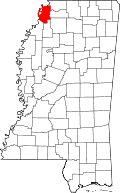Trotter Landing, Mississippi
| Trotter Landing, Mississippi | |
|---|---|
| Ghost town | |
 Trotter Landing, Mississippi | |
| Coordinates: 34°32′37″N 90°31′59″W / 34.54361°N 90.53306°WCoordinates: 34°32′37″N 90°31′59″W / 34.54361°N 90.53306°W | |
| Country | United States |
| State | Mississippi |
| County | Tunica |
| Elevation | 157 ft (48 m) |
| Time zone | Central (CST) (UTC-6) |
| • Summer (DST) | CDT (UTC-5) |
| GNIS feature ID | 692276[1] |
Trotter Landing (also Trotter's Landing) is a ghost town in Tunica County, Mississippi.
Once an important port on the Mississippi River, nothing remains of the original settlement.
History
The town was founded in 1820 by C. L. Moore, who operated a ferry to Helena, Arkansas, located on the opposite side of the river. The site was called "Glendale Landing" until 1846, when Captain John Trotter bought land there and changed the name to "Trotter's Landing".[2]
Trotter Landing was a busy riverport where agricultural products were produced and transported downriver.[3] The town's importance, however, did not grow beyond that of a riverport.[2]
In 1870, the Ohio Statesman reported that the steamboat Kenton, traveling from Cincinnati to New Orleans, struck a snag at Trotter Landing and was lying on its side on the river bank. The steamer was "probably a total loss".[4]
Trotter Landing was the terminus of a branch of the now-abandoned Mobile & North Western Railroad, constructed in the 1870s. The line traveled west to Trotter Landing from Lula, Mississippi.[5]
The 1910 Glidden Tour—an annual cross-county driving event sponsored by the American Automobile Association—crossed the "Father of Waters" at Trotter Landing. The Board of Trade in Helena sent large barges to the town to carry all the vehicles, and a portion of the levee had to be temporarily cut away.[6]
In 1915, the ferry from Trotter Landing to Helena was included as part of the route of the Southern National Highway.[7]
Decline
Factors contributing to Trotter Landing's decline include the widespread construction of railways following the Civil War, which greatly reduced the reliance on the Mississippi River as a method of transportation. The need for ferry crossings on the Mississippi River was also impacted by bridge construction, such as the Frisco Bridge in nearby Memphis, opened in 1892. As well, the Mississippi River changed its course and moved west of the Trotter Landing, leaving the town at some distance inland from the river.[3]
Today
Trotter Landing is significant to canoeists and paddlers on the Mississippi River. The town was located at the entrance to "Old River Chute", a historic oxbow lake described as "a primeval world ", accessible by small water craft from the Mississippi River.[8]
References
- ↑ U.S. Geological Survey Geographic Names Information System: Trotter Landing, Mississippi
- 1 2 "Communities of Tunica County, Mississippi". MSGenWeb. Retrieved March 2014. Check date values in:
|access-date=(help) - 1 2 George, David; Saucier, Roger; Barrett Smith, Susan; Pincoske, Jeremy; Hayden, William; Johnson, Rebecca; Crutchfield, Ryan; Bair, William; Athens, William P. (October 2000). "Cultural Resources Study Supporting Supplement I to the Final Environmental Impact Statement, Mississippi River Main Line Levee". U.S. Army Corps of Engineers.
- ↑ "The South". Ohio Statesman. May 6, 1879.
- ↑ Howe, Tony. "Trotter's Point, Mississippi". Mississippi Rails. Retrieved March 2014. Check date values in:
|access-date=(help) - ↑ "Auto Race for Glidden Trophies". The Evening Independent. June 8, 1910.
- ↑ "Good Through Route to Washington Now" (PDF). New York Times. February 28, 1915.
- ↑ "The Lower Mississippi River Water Trail". River Gator. Retrieved March 2014. Check date values in:
|access-date=(help)
